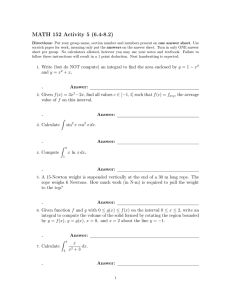Math 190 Homework 9: Solutions
advertisement
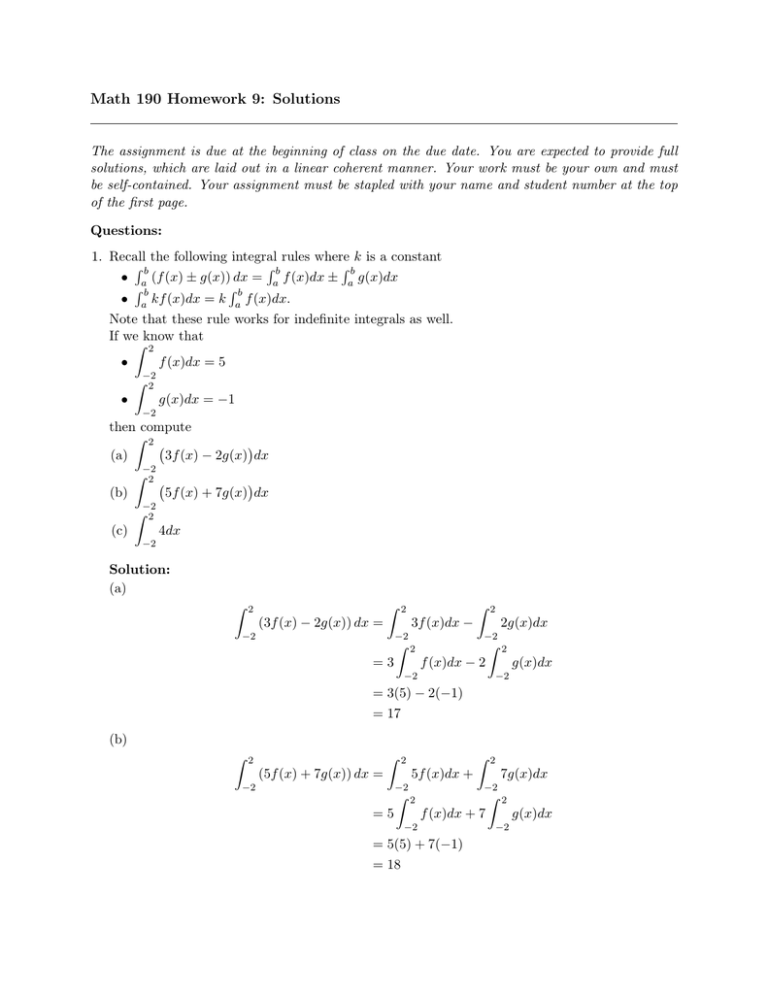
Math 190 Homework 9: Solutions The assignment is due at the beginning of class on the due date. You are expected to provide full solutions, which are laid out in a linear coherent manner. Your work must be your own and must be self-contained. Your assignment must be stapled with your name and student number at the top of the first page. Questions: 1. Recall the following integral rules where k is a constant Rb Rb Rb • a (f (x) ± g(x)) dx = a f (x)dx ± a g(x)dx Rb Rb • a kf (x)dx = k a f (x)dx. Note that these rule works for indefinite integrals as well. If we know that Z 2 • f (x)dx = 5 Z−2 2 g(x)dx = −1 • −2 then compute Z 2 (a) 3f (x) − 2g(x) dx Z−2 2 (b) 5f (x) + 7g(x) dx Z−2 2 (c) 4dx −2 Solution: (a) Z 2 Z 2 (3f (x) − 2g(x)) dx = Z 2 3f (x)dx − −2 −2 Z 2g(x)dx −2 2 Z 2 f (x)dx − 2 =3 g(x)dx −2 −2 = 3(5) − 2(−1) = 17 (b) Z 2 Z 2 (5f (x) + 7g(x)) dx = −2 Z 2 5f (x)dx + −2 Z 2 =5 Z 2 f (x)dx + 7 −2 = 5(5) + 7(−1) = 18 7g(x)dx −2 g(x)dx −2 (c) We can compute this integral several ways. We can compute the integral directly: Z 2 −2 2 4dx = 4x = 4(2) − 4(−2) = 16 −2 or draw the graph of the function f (x) = 4 and use the formula for the area of a rectangle −2 2 And so Area = length · width = 4 · 4 = 16. 2. Compute the following definite integral Z 2 1 √ 5 2x − 3 x − 2 x 3 dx. Solution: We compute the anti-derivative of each term: 2 Z 2 √ 5 1 4 3 3/2 −1 2x − 3 x − 2 dx = x − 2x + 5x x 2 1 1 1 4 1 4 3/2 −1 3/2 −1 = 2 −2·2 +5·2 − 1 −2·1 +5·1 2 2 √ =7−4 2 3. Compute the following definite integral Z 2 3 4 4e − x x dx. Solution: We compute the anti-derivative of each term: 3 Z 3 4 4ex − dx = 4ex − 4 ln x = 4e3 − 4e2 − 4 ln 3 + 4 ln 2. x 2 2 4. Suppose 5 Z f (x)dx = 7. 2 Find 2 Z f (x)dx. 5 Solution: We solve this problem in two ways. One is to suppose we have the anti-derivative F (x) and consider Z 5 f (x)dx = F (5) − F (2). 7= 2 Now Z 2 Z f (x)dx = F (2) − F (5) = −(F (5) − F (2)) = − 5 f (x)dx = −7. 2 5 Alternative we can add the two integrals together: Z 5 Z 2 Z f (x)dx + f (x)dx = 2 5 2 f (x)dx = 0. 2 Going from 2 to 5 and then from 5 back to 2 yields no net movement. Rearranging the above gives Z 2 Z 5 f (x)dx = − f (x)dx = −7. 5 5. Compute the following indefinite integral Z 2 2x + x3 √ dx. x Solution: To compute this integral we split the sum Z Z 2x x3 2x + x3 √ √ +√ dx = dx x x x Z √ 5/2 = 2 x+x dx 4 2 = x3/2 + x7/2 + C. 3 7 Note that since this is an indefinite integral we can add any constant C.
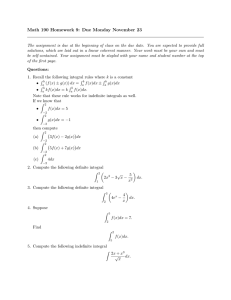
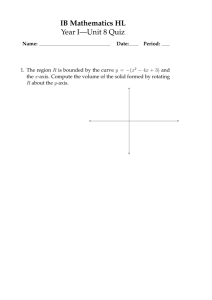


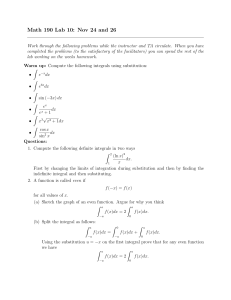

![MA2224 (Lebesgue integral) Tutorial sheet 7 [March 11, 2016] Name: Solutions R](http://s2.studylib.net/store/data/010730674_1-ca1a230eb5aca7dc4fc724de9a5a238d-300x300.png)
